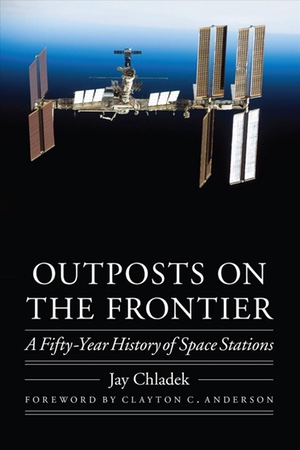Review: Outposts on the Frontier: A Fifty-Year History of Space Stationsby Jeff Foust
|
| “Since that time, many cosmonauts and astronauts have commented that the first ‘greeting’ they get from the opening of the hatches is the assault to their olfactory senses as the environments from the two spacecraft intermingle for the first time.” |
As the book’s subtitle suggests, the books starts back in the 1960s, reviewing the US Air Force’s cancelled Manned Orbiting Laboratory program. From there, it works its way roughly chronologically through American and Soviet efforts, including the series of Salyut stations, Skylab, Mir, and even the Spacelab missions on the shuttle before moving on to the ISS. China’s space station efforts also get a couple pages near the end of the book.
Chladek thoroughly goes through the histories of those stations, mission by mission, discussing who flew and when. There are some interesting details in particular about the development and operation of the early Soviet space stations, such as, for example, when the cosmonauts of Soyuz 27 docked with Salyut 6, where two cosmonauts had been living for weeks. “The visitors were greeted with warm wishes and a bit more, as they were initially a bit overwhelmed by the smell of the station,” he writes, which he attributed to the flatulence of the Salyut cosmonauts. “Since that time, many cosmonauts and astronauts have commented that the first ‘greeting’ they get from the opening of the hatches is the assault to their olfactory senses as the environments from the two spacecraft intermingle for the first time.”
While the book offers tidbits like that about lessons learned from past space stations, there are other missed opportunities elsewhere. Chladek goes through the development and operation of these stations, but with far less discussion about their programmatic and policy issues. The book, oddly, largely overlooks the early development of Freedom, from President Reagan’s 1984 announcement until it morphed into ISS. (Those topics are covered in much greater detail in Valerie Neal’s recent book, Spaceflight in the Shuttle Era and Beyond, recently reviewed here.) Like a number of other space history books, it focuses too much on the specifics of the missions—who flew and when—and less on the underlying motivations and rationales that led those missions to take place at all.
The book wraps up with the “completion” of the assembly of the ISS at the end of the shuttle program. (“Completion” is in quotes since more modules will likely be added to the station—Russia has some long-delayed ones in development, for example—before it is retired.) There’s not much discussion of what’s been going on at the ISS since then, or its future plans. Of course, the station’s future itself remains in question (see “Pondering the future of the International Space Station”, The Space Review, July 31, 2017) but even that speculation about what will happen to the station, and what will succeed it, is missing here. When the ISS does come to an end, it may represent not just an end of that program, but an end of an era of in government space stations—at least in the US—dating back half a century.
